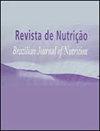Changes in the frequency of food consumption by adults/elderly according to food insecurity: evidence from a longitudinal study in the northeastern semi-arid region, Brazil, 2011-2014
IF 0.5
4区 医学
Q4 NUTRITION & DIETETICS
Revista De Nutricao-brazilian Journal of Nutrition
Pub Date : 2023-06-02
DOI:10.1590/1678-9865202336e220179
引用次数: 0
Abstract
ABSTRACT Objective: To prospectively analyze changes in the frequency of individual food consumption of adults/elderly people according to different food insecurity outcomes over time. Methods: Population-based longitudinal study carried out in 2011 (358 individuals) and 2014 (301 individuals) in a municipality in the northeastern semi-arid region. The frequency of food consumption of 37 foods in adults/elderly was assessed using the Food Frequency Questionnaire and food insecurity using the Brazilian Food Insecurity Scale. Differences in the proportion of frequency of consumption of each food at baseline (2011) and follow-up (2014) were calculated according to longitudinal categories of change in food insecurity. The McNemar test for paired samples was applied to estimate differences between 2011 and 2014. Results: Among the individuals studied, 38.9% and 30.6% were classified in food security and food insecurity in the two periods (2011 and 2014), respectively, and 23.2% changed from food insecurity in 2011 to food security in 2014. Increase in the frequency of food consumed in the three groups of food insecurity outcomes. Only in the food insecurity group at both times, an increase in the consumption frequency of soft drinks and industrialized juices was observed. In the three groups, when comparing 2011 and 2014, there was an increase in the consumption of local agricultural foods, such as mangoes, sweet potatoes and a decrease in the consumption of pumpkin. Conclusion: Overcoming food insecurity results in positive changes in food consumption, and seasonality is a factor that promotes and limits food consumption.粮食不安全背景下成人/老年人食物消费频率的变化:2011-2014年巴西东北半干旱区纵向研究证据
摘要目的:前瞻性分析不同粮食不安全结局下成人/老年人个体食物消费频率随时间的变化。方法:分别于2011年(358人)和2014年(301人)在东北半干旱区某市开展人口纵向研究。使用食品频率问卷和巴西食品不安全量表对成人/老年人37种食品的食品消费频率进行了评估。根据粮食不安全变化的纵向分类,计算了基线(2011年)和随访(2014年)时每种食物消费频率比例的差异。采用成对样本的McNemar检验来估计2011年和2014年之间的差异。结果:在研究个体中,2011年和2014年两个时期分别有38.9%和30.6%的个体处于粮食安全和粮食不安全状态,23.2%的个体从2011年的粮食不安全状态转变为2014年的粮食安全状态。三组粮食不安全后果中食物消费频率的增加。只有在两种情况下,在食品不安全组中,软饮料和工业化果汁的消费频率有所增加。在这三个群体中,当比较2011年和2014年时,芒果、红薯等当地农业食品的消费量增加,南瓜的消费量减少。结论:克服粮食不安全导致粮食消费发生积极变化,季节性是促进和限制粮食消费的因素。
本文章由计算机程序翻译,如有差异,请以英文原文为准。
求助全文
约1分钟内获得全文
求助全文
来源期刊
CiteScore
1.20
自引率
12.50%
发文量
24
审稿时长
6-12 weeks
期刊介绍:
Revista de Nutrição is former Revista de Nutrição da Puccamp, founded in 1988. It is a bimonthly publication every four months and it is of responsibility of the Centro de Ciências da Vida, da Pontifícia Universidade Católica de Campinas . It publishes articles that contribute to the study of Nutrition in its many sub-areas and interfaces; and is open to contributions of the national and international scientific communities.

 求助内容:
求助内容: 应助结果提醒方式:
应助结果提醒方式:


